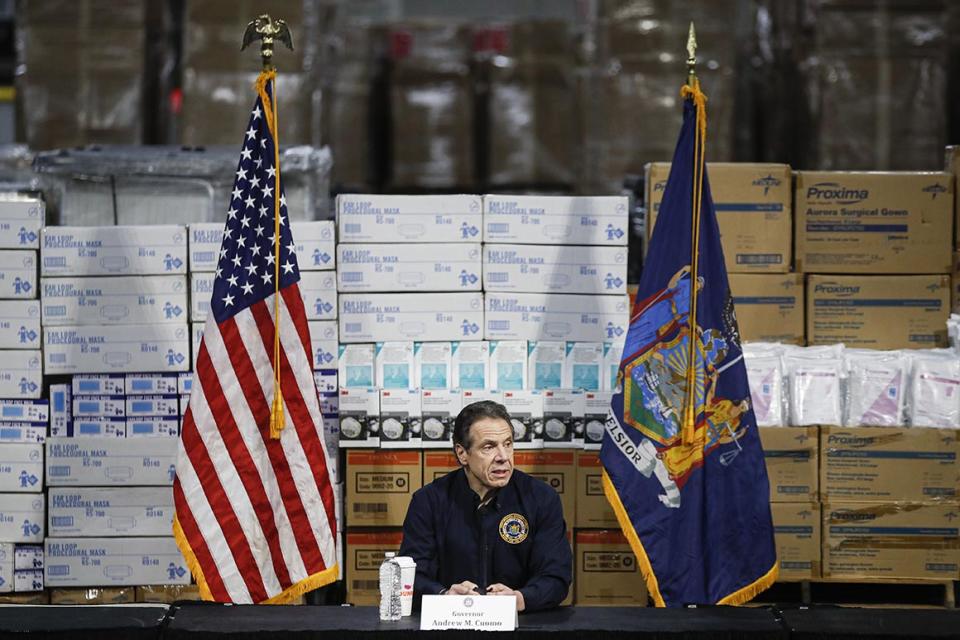Governors see possible 'flattening' of the curve in latest coronavirus data

The number of coronavirus infections and deaths continue to mount across the United States, but governors in some of the nation’s hotspots said Monday they see glimmers of hope in the latest data on the pandemic — evidence the rigid social distancing measures states have mandated are helping slow the spread of the virus.
In New York, home to by far the largest outbreak in the country, more than 130,000 people have now tested positive for Covid-19, the disease caused by the novel coronavirus, out of more than 300,000 total. That figure includes an additional 8,658 cases added on Sunday. The state has 16,000 patients in its hospital system — 13,000 people have been discharged — and 4,758 people have died, more than half of the nearly 9,000 total deaths in the U.S.
The number of fatalities, however, has been “effectively flat for two days,” New York Gov. Andrew Cuomo said at a news conference Monday. Cuomo also noted that the total number of hospitalizations, ICU admissions and intubations are down.
“Those are all good signs and, again, would suggest a possible flattening of the curve" that tracks the number of cases, he said.
Next door, New Jersey now has the second-worst outbreak of the virus. More than 41,000 people in New Jersey have tested positive, and more than 1,000 people have died. But Gov. Phil Murphy tweeted Monday that New Jersey’s curve is also flattening.
Still, he warned that “this is no time to spike any footballs or to take our foot off the gas.”
“We still have a week-and-a-half to go, at least, until we hit the peak,” Murphy said. “This isn’t over – not by a long shot.”
The potential bright spots in New York and New Jersey follow recent improvements in Washington state and California, which were the first two states to experience major coronavirus outbreaks. In both states, the governors took early steps to curb the spread of the virus.
Washington Gov. Jay Inslee declared a state of emergency on Feb. 29 and began limiting visitors to nursing homes and assisted living facilities, banning large crowds and closing schools within the next two weeks. Inslee announced Sunday that his state would return more than 400 ventilators to the national stockpile for New York and other states to use.
In California, Gov. Gavin Newsom declared a state of emergency on March 4. He announced a week later that large gatherings should be canceled or postponed and issued a stay-at-home order on March 19.
Newsom announced Monday that California was securing tens of thousands of additional beds to treat patients and expanding its health care workforce “significantly.”
“This is an all hands on deck effort, and I am extremely grateful to all of our partners in the medical community, the private sector and across government for helping us get this far,” he said in a statement. “All of these efforts will only pay off if we continue to slow the spread of the virus. Staying home will save lives.”
Administration officials have cautioned that this week may be the hardest for many Americans, although President Donald Trump has continued to insist he sees light at the end of the tunnel.
“It seems to be inherently contradictory, but it really isn’t,” Anthony Fauci, director of the National Institute of Allergy and Infectious Diseases, said at a White House briefing Sunday. “It has to do with what we explained before about the lag in when you look at the indications that Dr. [Deborah] Birx and the president was talking about, where you see a flattening out of cases.”
“You don’t see the realization of what that means until two weeks later,” Fauci continued. “So right now we’re seeing, as we all said correctly, that this is probably gonna be a really bad week. That is a reflection of what happened two-and-a-half weeks ago. So if we start seeing now a flattening or a stabilization of cases, what you’re hearing about potential light at the end of the tunnel doesn’t take away from the fact that tomorrow or the next day is gonna look really bad.”
Cuomo said the question New York is now trying to answer is: “What is the curve?”
“We’ve been talking about cases increase, increase, increase until they don’t,” he said Monday. “When they stop increasing, then what happens?”
Projection models indicate that New York’s curve could go up and drop precipitously, pause at the top or go straight up and then straight down.
“No one can tell you which will occur. They say any one of the three options,” Cuomo said. “We are studying it as we use the projection models from Day One to determine, actually, what we do.”
Cuomo has emerged as one of the key faces of the nation’s response to the coronavirus pandemic, delivering daily briefings to New Yorkers that are often broadcast on national television.
In the absence of a national order to close businesses and keep people at home, the New York governor formed a regional coalition with New Jersey, Connecticut and Pennsylvania last month to uniformly limit the number of people who could gather in groups and close nonessential establishments throughout the region.

